How to choose paint for cast iron heating radiators? Step-by-step painting process
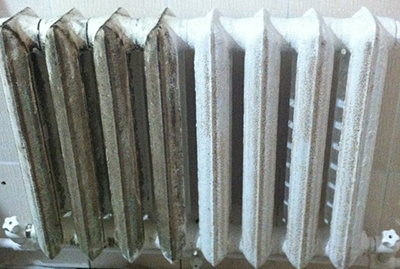
In our climate heating is required 6-7 months a year, therefore radiators are an integral part of the interior.
Cast iron radiators do not look the best, and it is not always possible to cover them with grates.
To prevent the radiator from spoiling the appearance of the room, you can use paints make her attractive.
Content
We select paint according to its characteristics

Before buying, decide on the color and texture of the paint. The texture can be glossy, semi-matte or matte, Hammer paints mask all defects, do not require primer, and are applied to rust.
In addition to compositions in cans, enamels are produced in the form of aerosols, significantly speeding up painting.
Basic requirements to paint compositions for radiators:
- Heat resistance. Must be able to withstand temperature not less than 80 °C, paints that do not meet this requirement turn yellow, peel off, and the coating cracks.
- Environmentally friendly. The composition should not emit toxic substances or unpleasant odors.
- Good adhesion – strong adhesion of the paint layer to the base.
- High thermal conductivity – the coating should not impede heat exchange.
- Moisture resistance – the composition must withstand washing or leakage in the heating system.
- Resistance to mechanical damage.
What to paint: types of enamels for cast iron heating batteries
Heat-resistant enamels for cast iron radiators are produced resin based (alkyd, acrylic, silicone), aqueous dispersions (acrylic and silicone), there are also powder paints, but their use requires special equipment, painting is carried out in factory conditions.
For painting at home with your own hands, acrylic compositions (water-soluble or based on organic solvents) and alkyds are popular.
Alkyd
Alkyd-based enamels contain pigments, special additives, and a thinner – pentaphthalic or glyphthalic varnish. A common alkyd enamel is pentaphthalic PF-115. The compositions are affordable, have good hiding power, are durable, wear-resistant, and have a wide range of colors.
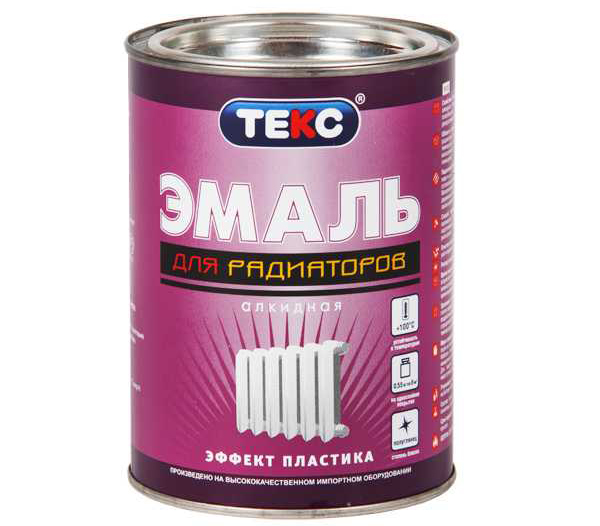
Photo 1. Alkyd enamel for cast iron heating radiators with a plastic effect from the manufacturer "Tex".
Disadvantage of enamels – drying time and unpleasant smell, which remains in the room for several days, can appear at high temperatures of the coolant, enamel cannot be called harmless.
Reference! Alkyd enamel apply in 2 layers onto a pre-primed surface with a brush or using a spray gun.
Water-dispersion acrylic
Water-based acrylic enamel dries quickly, the paint layer is smooth, even like plastic. It has no smell, does not burn, safe and environmentally friendly, has high adhesion to metal.
The disadvantage of acrylic water-dispersed enamels is abrasion resistance (the surface cannot be cleaned with powders).
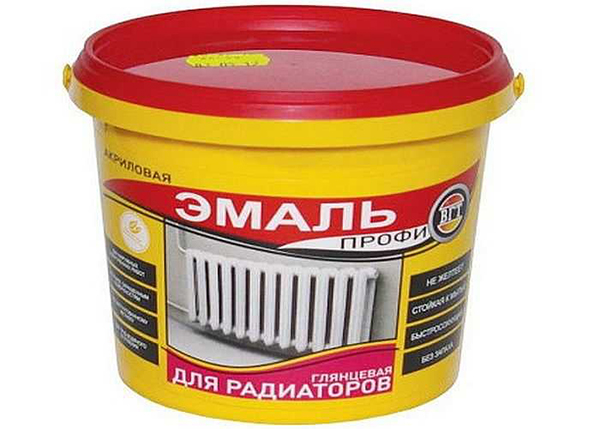
Photo 2. Acrylic glossy enamel for cast iron radiators PROFI VD-AK-1179 dries quickly and leaves no odor.
Acrylic with solvent
In addition to acrylic resin, the composition includes pigments, additives and a solvent – white spirit. The enamel forms a durable and stable coating, the paint can be applied to surfaces previously treated with acrylic or alkyd composition. Layer durable, does not turn yellow over time.
The disadvantages include an unpleasant smell and a long drying time – painted surface dries in about 8 hours, the second layer is applied in 24 hours.
How to paint a battery with your own hands
If the manufacturer's instructions do not indicate the possibility of applying the composition to old paint, then the radiators require preliminary washing, cleaning from the old paint layer, then priming and painting in 2 layers.
Work is underway in protective glasses, a respirator and gloves.
Attention! Workwear set – the best protection against harmful dust and chemicals. To protect the area around the radiator from accidental splashes, the surfaces are protected with polyethylene film, cardboard or paper.
Wiping the radiator
Use a brush or vacuum cleaner to remove accumulated dust and small debris.
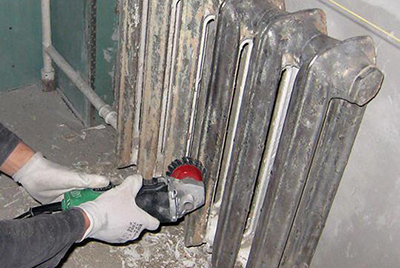
Wash everything thoroughly with detergent internal and external surfaces.
Remove the old paint layer with one of 3 ways:
- washed off with a chemical composition;
- removed mechanically using a drill and special attachments - brushes;
- soften old paint with a hair dryer or a burner, and remove with a spatula.
Removing old paint
Chemical compounds for removing old paint (washers) are produced in the form of liquid or aerosols.
Important! When choosing a cleaning solution, pay attention to the composition: it must include components that prevent corrosion.
The softened paint layer is removed with a spatula, a rag will do. Removing paint without softening is done using a drill with a brush attachment with metal teeth. Having cleaned off the old paint, the surface is dedusted: manually – with a brush, a brush or a vacuum cleaner.
Sanding the surface
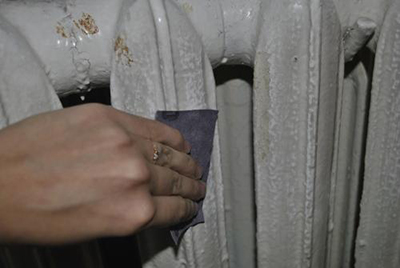
Radiator surface sanded down to bare metal. This work can be done manually with sandpaper, but cleaning with a sanding machine is faster and more efficient.
Dust-free surface degrease, if you plan to paint with alkyd compounds - gasoline or white spirit, when painting with acrylic - acetone.
Primer
Before priming, there are defects and large irregularities they putty. Use a metal putty designed for high (from 80 °C) temperature (epoxy, automotive). The dried layer is sanded, dusted and degreased.
The primer is selected in accordance with the paint. Some manufacturers allow the use of water- or solvent-diluted paint instead of primer (5% of the volume). This point should be described in detail in the instructions for the paint.
Coloring
To paint a battery correctly, you need brushes-flutes: medium width with a straight handle and narrow with a curved handle.
Attention! Instead of a flute with a curved handle, you can make a pad made from a piece of foam rubber, fixed on a wire. The wire can be easily bent at the desired angle, all hard-to-reach places can be easily painted.
Primed metal base practically does not absorb paint.
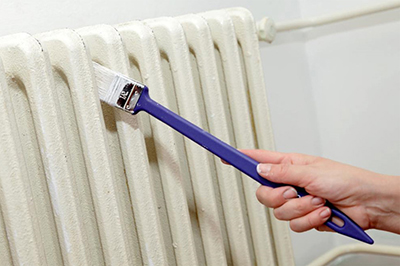
Therefore, to avoid drips, a small amount of paint is applied to the brush and it is carefully distributed over the surface in a thin layer.
The spray paint can is held vertically at a distance of 30 cm from the surface, apply the composition with a zigzag motion.
Staining sequence – the back surfaces from top to bottom, then the top, sides and inner parts, and lastly the front side and bottom of the battery.
Second layer paints are applied after the first layer has dried.
Useful video
The video provides recommendations on the correct selection of paint for radiators, and describes how to evenly paint a radiator.
Conclusion: Let's give cast iron a second life
Giving a second life to a radiator is easy - do it yourself, following the technology, using paints from an old, nondescript device you will make it indistinguishable from a new one.








Comments